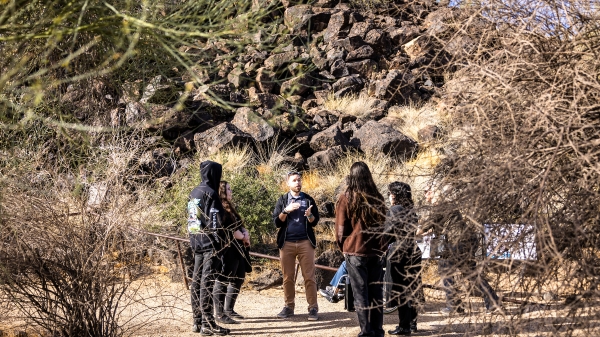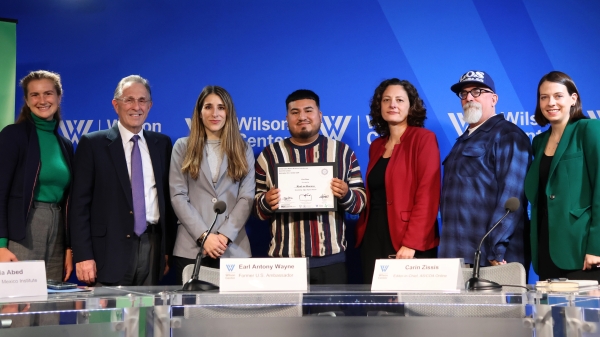Building the future: Architect and educator Renée Cheng named senior vice provost, dean of Herberger Institute
Renée Cheng is no stranger to Arizona.
Her first tenure-track position, in 1996, was as an assistant professor of architecture at the University of Arizona. Now, almost three decades later, Cheng returns to Arizona as the new dean of the Herberger Institute for Design and the Arts and a senior vice provost at Arizona State University, beginning Nov. 1.
Cheng succeeds Dean Steven Tepper, who served as dean and director of the institute for 10 years before his inauguration as the 21st president of Hamilton College last month. Under Tepper, the institute launched The Sidney Poitier New American Film School and ASU FIDM, ASU’s new school of fashion, and expanded to downtown Phoenix (Grant Street Studios and Fusion on First), Mesa (the MIX Center) and Los Angeles (ASU California Center).
At every stage of learning more about the position as dean and senior vice provost, Cheng says she grew more and more excited — "about what the Herberger Institute is, what it could be, and where ASU is going.”
“Leading a community that is so creative and diverse is a huge opportunity as well as a responsibility,” she said. “I’m looking forward to learning more about all the fantastic things already happening as well as finding new synergies and collaborations.”
From Tucson, Cheng’s career led her to the University of Minnesota, where she served as a professor, associate dean of research and head of the school of architecture, as well as directing an innovative graduate program linking research with practice and licensure. In 2019, she accepted a position at the University of Washington, where she was the dean of the College of Built Environments.
A licensed architect, Cheng worked for Pei, Cobb, Freed and Partners, and Richard Meier and Partners before founding Cheng-Olson Design. She has twice been honored as one of the top 25 most admired design educators in the United States by DesignIntelligence. She has received numerous honors and awards, including elevation to the College of Distinguished Professors for the Association of Collegiate Schools of Architecture and American Institute of Architects' College of Fellows in 2017.
Cheng is a leader in the American Institute of Architects (AIA) and advocates for equity in the field of architecture and in the practices related to the built environment. Recently, she led the research effort for the AIA guides for equitable practice in the workplace. She has pioneered research surrounding the intersection of design and emerging technologies, including work on industry adoption of integrated project delivery, building information modeling and lean.
Cheng earned her bachelor’s degree in psychology and social relations from Harvard College. She went on to receive a professional degree in architecture from Harvard’s Graduate School of Design.
“Dean Cheng is a uniquely capable design thinker who is adept at toggling between the view from 30,000 feet and the view on the ground to find elegant solutions,” said ASU President Michael Crow. “With the Herberger Institute operating across two states and four cities, she is the right person at the right time to lead the institute into the future.”
“Renée Cheng’s experience and skill, her ability to combine a respect for tradition with an appetite for innovation, and her long-standing focus on equity and academic excellence all mean that the Herberger Institute is in excellent hands,” said Executive Vice President and University Provost Nancy Gonzales, whose office led the search.
In a conversation with Herberger Institute faculty and staff, Cheng explained that in addition to being an industry leader, an academic leader, an educator and an architect, she is also a painter, a draftsman, a ceramicist, a weaver and an early adopter of VR. In fact, she almost left architecture for ceramics at one point, and did serious ceramics — a show and sales in New York — for about a year and a half.
Cheng’s mother was an artist whose last year of teaching at the University of Michigan was Cheng’s first year of teaching, at the same university, and the two were able to collaborate.
“It was an extraordinary opportunity,” Cheng told an interviewer with Madame Architect about the experience. “I had been in the back of her classroom as a child, but this was the first time in my relationship as an adult that I was able to really discuss and understand her teaching. She was a great teacher. … I went to her class and taught one- and two-point perspective, and she came to my class and taught collage. We had an exhibit together of Cheng and Cheng in Italy, where we were sketching the same scene side by side with different styles. We shared a mailbox and had offices down the hall from each other.”
Cheng believes that design and the arts have a critical role to play in advancing solutions to the world’s most pressing and complicated problems.
“Society often relegates design and the arts to something that’s like icing on the cake — a luxury,” Cheng said. “But there are aspects of societal needs that can only be solved through design and the arts, in collaboration with other disciplines, whether it be material science, ecological studies, behavioral economics. These are things that affect how people operate in the world, how we as a planet are going to be dealing with things like climate change, housing, democracy.
“I feel that it is actually through design and the arts, facilitated by and provoked by things that design and the arts can do — to pose the what-ifs, to show what the possible futures are, to inspire people, to challenge people in ways that are accessible and profoundly connected — that we will advance toward solutions. These problems are not going to be solved without the type of thinking the Herberger Institute provides.”
Cheng notes that, as a university, ASU is in a special position to help find solutions, in large part because of its willingness to break down barriers.
“At ASU, I sense an appetite for risk I’ve not ever seen in higher ed. When you have a higher ed institution that’s committed to access plus excellence, together with an appetite for risk, there’s a lot you can change.”
More Arts, humanities and education

Petroglyph preserve celebrates 30th anniversary with ancient, modern tales
The Deer Valley Petroglyph Preserve provides a beautiful walk through a pristine desert where chuckwalla lizards are as plentiful as the cacti that comes in many shapes and sizes.It’s also a step…

Kaleidoscope short film contest inspires powerful binational filmmaking in its second year
“We come to this country not to steal anybody’s jobs but to take advantage of the opportunities that the rest ignore. We’ve been taking care of the American soil for many years. But our hands will…

ASU's Neal Lester reflects on life, death of poet Nikki Giovanni
When Neal Lester heard on Monday that poet and activist Nikki Giovanni had died, the news hit hard.Lester, the founding director of Arizona State University’s Project Humanities and a Foundation…
